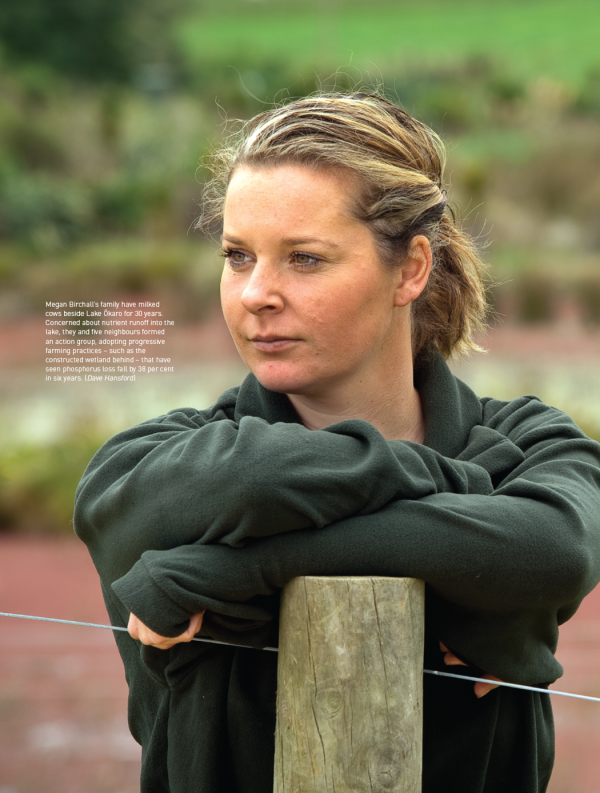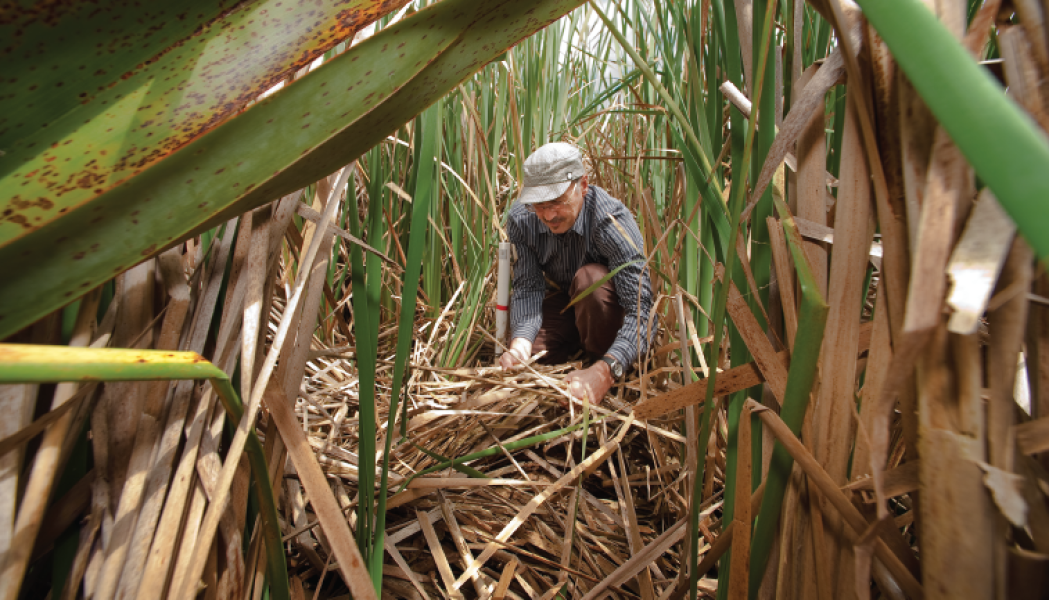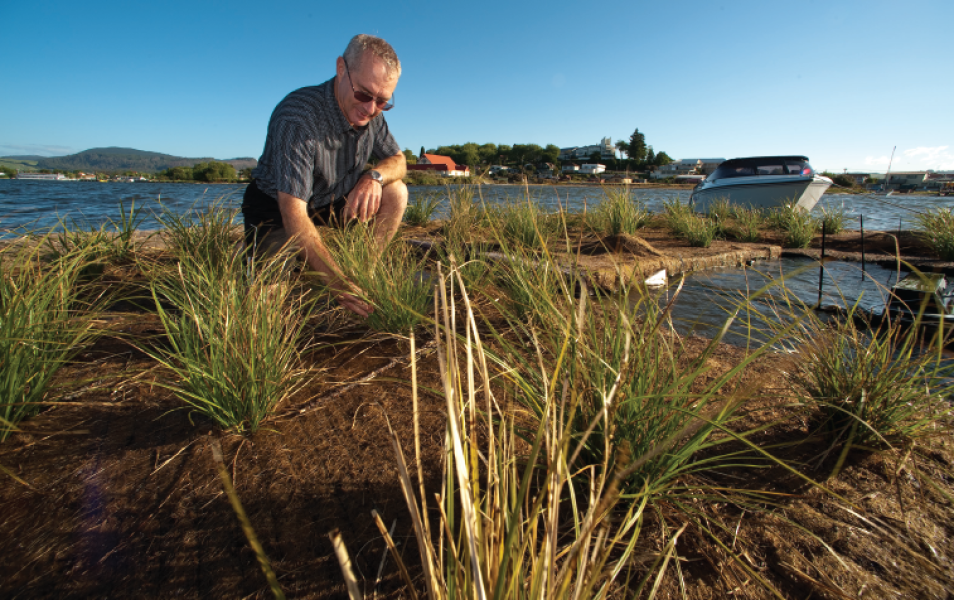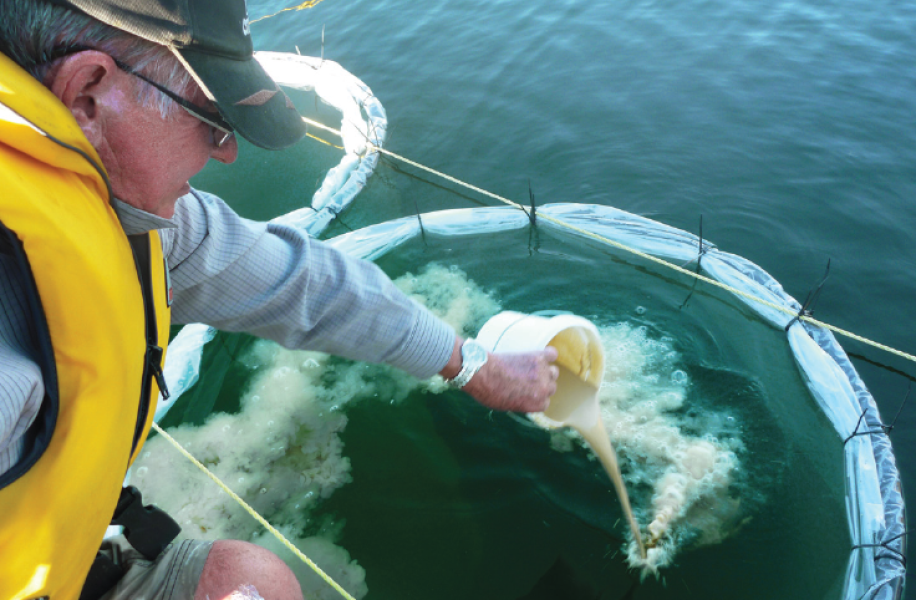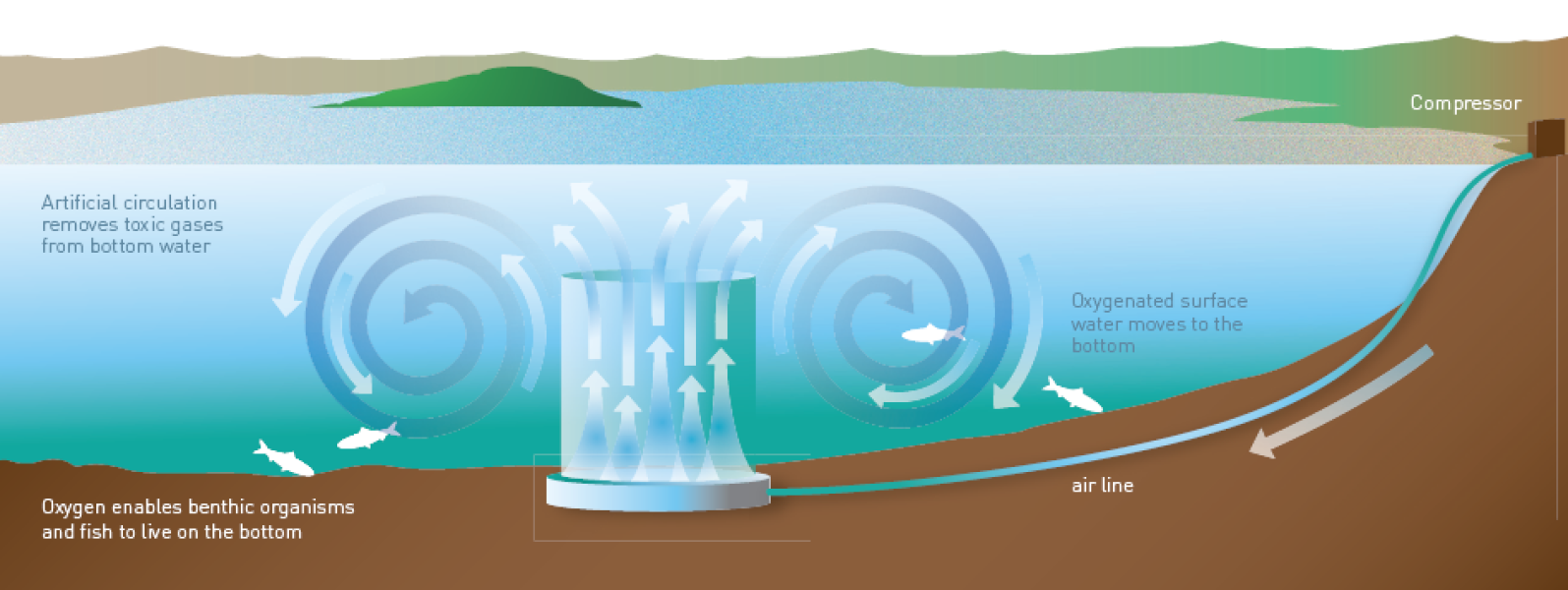"We want fertile land, not fertile water." So said Parliamentary Commissioner for the Environment, Jan Wright, earlier this month. In her latest report: Water Quality in New Zealand: Understanding the Science, she referred to nitrogen and phosphorus runoff as "the focus of most concern today."
Dave Hansford looks at the various ways NIWA's helping to cleanse some Rotorua lakes of these pernicious pollutants.
Each day, every dairy cow in the country wees out 23 litres of urine, and according to Statistics New Zealand figures last year, there were 6.2 million of them. There were also 3.9 million beef cattle, which means our landscape gets drenched with more than 230 million litres of bovine urine (plus the outpourings of calves and 32.6 million sheep) every day.
Once it hits the ground, billions of soil bacteria go to work, breaking down urea in the urine, first into ammonium, then nitrites and finally nitrates – the first few steps in a global nitrogen cycle. All living things need nitrogen, to make DNA, proteins and amino acids. It's also a vital plant nutrient, but the majority of nitrogen occurs naturally as inert gas (it makes up 78 per cent of the atmosphere) which plants can't access directly – they need nitrogen-fixing bacteria to convert it to a soluble form they can use.
The production of nitrogen fertilisers, and atmospheric fallout from fossil fuel combustion, has roughly doubled the supply of plant-available nitrogen to Earth's ecosystems. That's seen agricultural production soar, but it's come at a cost to water quality.
A single urine patch can carry nitrogen loadings equivalent to a tonne per hectare (you can see the urine patches in any paddock: the grass is darker and longer), and soil, plants and cattle can only reabsorb so much. The rest, being so very soluble, leaches away with the next rain.
The volumes are huge: more than 750 tonnes of nitrogen run into Lake Rotorua each year – less than 100 tonnes of it from 'natural' sources. That sort of fertility sends plants into overdrive: algae run riot, exploding into blooms and sometimes even forming thick mats of toxic scum.
Even as algae thrive, other organisms suffer: high levels of dissolved nitrate have been shown to stunt development and reproduction in aquatic invertebrates and fish, or kill them outright.
When the bloom ends and all those algae die, the massdecomposition can rob so much oxygen from a lake that bigger creatures die with them.
In 2006, regional council data revealed that, of 134 monitored lakes, 56 per cent were eutrophic – full of enough nutrients to trigger a bloom – or worse. Rivers are faring no better. NIWA manages the National River Water Quality Network, a monitoring programme that regularly samples 77 sites country-wide. They're showing data trends that head obstinately in the wrong direction: between 1989 and 2007, overall nitrogen loads increased by 1.4 per cent each year. Phosphorus concentrations mostly followed suit.
Find out more about our National River Water Quality Network
Slowing the flow
On this November morning, an oily film clings to the reed beds along the shore of Lake Ōkaro, south of Rotorua – the first sign of a looming bloom. Megan Birchall's seen it countless times. She and her parents run a dairy farm right across the road – 60ha of it drains to Ōkaro – and they're critically aware of what that means for the lake.
"My family's been on this property for 30 years," she says, "so we've seen Ōkaro in all its forms. Dad realised that, being right on the lake edge, we needed to change our management practices to mitigate what we were doing."
In winter, this Rotomahana silt loam is quick to bog: that's when nitrates either leach, or simply run straight off, into the nearest watercourse. So the Birchalls make sure their 450 cows never stand too long in wet paddocks. They spend some of each rainy day in two 'herd homes' – vast covered stand-off yards, with slatted floors that allow effluent to run through, down into holding tanks. The homes cut the farm's nitrogen loss into Ōkaro by an estimated 30 to 60 per cent.
The collected effluent is later pumped back onto the pasture as fertiliser, but only at times, and rates, that ensure it can be converted into grass growth with minimal losses. "Dad always gets me to check the soil moisture content nowadays, before he even thinks about putting effluent on," says Birchall. "It's the first thought that enters his head – whether it's going to run off or not. Even 10 years ago, nobody really thought that hard about it."
Her grandfather fenced off the farm's streams long before it was common practice, to keep cows and their by-products out of the water, and the cows only get milked once a day now. But the Birchalls' biggest commitment writhes, like an eel, across the flats below us. Ranks of flax and cabbage trees crowd shallow ponds where, just this morning, a flock of grey teal ducks have arrived. Pied stilts fossick beside beds of reeds. Out of the paddocks to the north, a serpentine stream wends through thickets of rushes. Their stalks and roots are one of nature's most efficient filters, trapping suspended sediments, nitrogen and phosphorus, and slowing the flow before the stream empties into Lake Ōkaro.
Only two centuries ago, wetlands like this stretched for mile after marshy mile. Landcare Research estimates wetlands once covered 2.4 million hectares – nearly ten per cent of the country – soaking up and purifying floodwaters before gently releasing them into rivers and lakes. But the colonists regarded wetlands as an untenable waste of scarce flat land: they burnt, cut and drained with such zeal (empowered by the Swamp Drainage Act of 1915) that, today, just ten per cent – around 250,000ha – survive.
Which is why the Birchalls' wetland had to be built again, from scratch. In 2007, when Bay of Plenty Regional Council (BOPRC) announced plans to rebuild a small wetland across the road, the Birchalls gifted two retired paddocks immediately behind it, adding another 2.3ha to the project. Diggers excavated the ponds, and a stream, deliberately designed to wind over as much of the wetland as possible, to maximise its cleansing power. Trucks delivered sawdust and topsoil, into which went 60,000 native plants.
NIWA's Chris Tanner designed it. "Wetlands are really my thing," says the freshwater scientist. "They're beautifully adapted to deal with water treatment issues.
"We know wetlands are very good at settling out and retaining suspended sediments. We also know they're very good at removing nitrogen, because their saturated soils and plant detritus support bacteria that convert nitrate back into nitrogen gas, so it can be released back into the atmosphere. "We know how these processes work, but it's much harder to determine how well they're working. How big does a wetland need to be, for instance, to remove any given volume of contaminant-laden sediment? Dissolved nitrogen? A pocket handkerchief wetland can't perform magic. You need something with enough size and integrity to process the load and deal with all those fluxes and fluctuations – particularly the highly variable flow regime."
Tanner's serpentine design disperses and holds water in the system for the longest possible time, so that plants, soil and microbes can thoroughly cleanse it. The right mix of plants is important, he says, but hydrology is critical. If a wetland is hit by sudden, large inundations – what Tanner calls "pulse" flows – and can't hold them for long enough, "it's going to struggle. You're not going to get much nutrient removal."
Constructed wetlands don't come cheap, which is why Tanner believes in "making them work for their money." To that end, he's keen to know just how much nutrient wetlands can sustainably retain. So he and his NIWA colleagues calculated wetland performance against expanse, to give farmers an idea of how much of a catchment they'd need to achieve a given target. They found that, on average, one per cent of a catchment could trap about 20 per cent of nutrients. "Set aside five per cent, and you're removing between 50 and 60 per cent – although that will vary from year to year."
Constructed wetlands, then, can be efficient filters, but the benefits don't stop there – they also absorb greenhouse gases, store carbon, contain stormwater flows and erosion, and provide safe nurseries for fishes and habitat for waterbirds. Collectively, those functions are known as ecosystem services, and wetlands provide them free of charge.
"So looking more broadly," says Tanner, "towards landscape and biodiversity values – those benefits accrue to a much wider section of society than just farmers. Once you add up all the different services, constructed wetlands can be really quite cost-effective."
Which raises another interesting issue: if everybody benefits, should farmers have to bear the costs alone? BOPRC doesn't think so: since 2005, it's funded some three-quarters of the environmental works on the Birchall farm; a recognition that they benefit a much wider community.
That's the carrot: the stick is what Megan Birchall calls "targeted ratings", essentially a regional council tax on nutrient runoff. For now, they're only a rumour at Ōkaro, raised several years ago, but the prospect persists. "Basically, it means we'd be charged a per-hectare rate for our discharge," she says. "I think it was probably going to cost us around $50,000 a year."
It was enough to galvanise the Birchalls and six of their neighbours: in 2009, they formed the Ōkaro Catchment Lake Restoration Group. Supported by the Sustainable Farming Fund, they're looking for ways to ease the consequences of their operations for the lake. BOPRC calculated each property's average nutrient loss from between 2001 and 2004, then set those figures as benchmarks. Ever since, the group's been putting their stocking and production figures through a dedicated software programme, Overseer, to analyse any trends. So far, phosphorus loss is down 34 per cent, but nitrogen remains stubbornly slippery: it's slightly up at three per cent.
P soup
As the Council's Lakes Operations Manager, it's Andy Bruere's task to nurse 12 Rotorua lakes back to health, under the Rotorua Lakes Protection and Restoration Action Programme. Not all are equally sick: four are eutrophic – which means they carry high nutrient loads – four are oligotrophic, or healthy, and four, described as mesotrophic, sit somewhere in between.
The Regional Council has set an annual target nitrogen load for Lake Rotorua of 435 tonnes; a volume not seen since the early 1960s. Around the five most polluted lakes – Rotorua, Ōkaro, Rotoiti, Rotoehu and Ōkāreka – it's also prescribed nutrient discharge limits for properties larger than 4000m². As at Ōkaro, landowners in those catchments have been benchmarked.
Another regulatory option, currently being modelled by Motu Economic and Public Policy Research Trust with input from NIWA and GNS Science, is nutrient trading. Similar to the emissions trading scheme, nutrient trading is based on 'cap and trade'. The 'cap', set by regulation, is the total amount of nutrient that farmers can discharge. Those who reduce their nutrient runoff below their allocation can 'trade' any surplus with those that haven't.
To that end, NIWA scientists have helped develop NManager, a computer model that simulates the generation of nitrogen on farms around Lake Rotorua, the times it takes to reach the lake, and the economics of alternative nitrogen 'cap and trade' schemes in the catchment. The model is helping BOPRC to develop policy to reduce nitrogen loads, and to assess the advantages of a 'cap and trade' scheme over regulation.
But farming isn't the sole culprit: leaky sewage reticulation and septic tanks are responsible for up to 25 per cent of some lake phosphorous loads. A geothermal vent at Hell's Gate releases 30 tonnes of nitrogen into Lake Rotorua every year, and the volcanic plateau's pumice soils are naturally high in phosphorus to start with, one reason why the Rotorua lakes are especially prone to eutrophication.
And people don't often realise, points out Bruere, that even healthy lakes naturally recycle nutrients from sediments. "That's not a bad thing, but when a lake becomes eutrophic, that natural circulation becomes much more significant."
The Council's water and land plan sets a target trophic level for each lake, "but they're not all going to be pristine, oligotrophic lakes," he cautions, "even if we meet all the trophic level indices. In fact, some of them will still be eutrophic – they'll just be at a more acceptable level."
They range in size from 8000ha down to 30ha. Bruere says the smaller lakes offer a valuable test bench for engineering "interventions" because any results show up faster. Because there's a raft of different problems, the Council – in partnership with NIWA, GNS Science, AgResearch and Waikato University – has come up with a range of proposed solutions.
Fix or float?
In an ideal world, the lakes would once again be surrounded by wetlands – cradled, shielded, by their reedbeds. But not everyone has the spare land, or the inclination, of the Birchalls. Bruere isn't fazed: if you can't make more wetlands on land, he figures, why not put them out on the lake itself?
Here on Lake Rotorua, a stiff nor'easter is goading the waters into a troublesome chop, but Bruere coaxes the boat skilfully into the lee of what he likes to call a giant SpongeBob. It's an island of what used to be soft drink bottles, reconstituted into a fibrous mat. Between the fibres is a foam that makes this plastic island so buoyant we can, with some awkwardness, step ashore.
The thing heaves and bucks under our steps, as Bruere checks the cleats that keep it moored to the lake bed, off the Ohinemutu shore. Cores have been drilled out of the SpongeBob, and in their place, native rushes and reeds have been planted. Theirs is a hydroponic life: their roots dangle clean through the island and half a metre into the lake. Collectively, they're a floating wetland, the latest thing in lake restoration.
At first, Chris Tanner thought they were a gimmick, "but then we started to realise they had a few advantages." Unlike their earthbound counterparts, he says, floating wetlands are immune to fluctuating water levels, and can be installed in almost any dam, treatment pond, reservoir, lake or estuary.
The tangle of roots attracts microbes that de-nitrify the water, and the mat casts a shadow that hampers algal photosynthesis. In a recent trial, Tanner found that those roots could remove 40 to 60mg of phosphorus per square metre each day, and between 500 and 800mg of nitrogen.
But perhaps their biggest benefit, he says, is that they're in peoples' faces. "They get people thinking and talking about water quality; it helps them connect the dots." The proof is just 30m away. The people of Ohinemutu marae have taken a lead from the floating wetland, removing willows and gorse from their lakeshore land, and planting wetland rushes in their stead.
If the cap fits...
Most Rotorua summers and autumns, still air and warmer temperatures tend to trap cold lake waters near the bottom for up to a fortnight, kept apart from sunlit upper waters by a distinct thermocline. When that happens, sediments start losing oxygen, which in turn allows nutrients to escape. In Lake Rotorua, this can happen three or four times a year, releasing around 360 tonnes of nitrogen and 36 tonnes of phosphorus each time. That's when Bruere has another algal bloom on his hands.
NIWA's helping him find a solution. A sediment cap is a thin layer of material that can adsorb phosphorus at the lake bed, permanently binding it to that material. Once locked in, or adsorbed, it's permanently denied to algae.
NIWA Limnologist and Environmental Chemist Max Gibbs has trialled a number of different capping, or inactivation, agents: alum – an aluminium-based chemical commonly used in drinking water treatment; allophane – a natural central North Island volcanic ash; Phoslock – a modified bentonite clay; and Aqual P – a modified zeolite clay developed by Scion.
All those substances encourage particles to clump together, either locking nutrients into the sediment, or neutralising them. "The trick is to apply enough inactivation agent to neutralise all of the phosphorus in the sediment. That takes detailed testing beforehand," says Gibbs, who scaled up successful laboratory trials to lakes such as Rotoehu, using 1.6 metre-wide tubes, or mesocosms, suspended vertically from the surface to the lake bed.
"We've pretty much got a handle on the loading rates needed to treat sediments in the lake, and how long they'll last." Trials at Lake Ōkaro have shown capping can quickly lock up bottom-sediment phosphorus, denying blue-green algae the fertiliser they need to bloom. "In summer 2009/10, Ōkaro was mesotrophic for the first time in 20 years."
But there's a problem, says Bruere: "Lake Rotorua, for instance, accumulates sediment at around one centimetre a year, so any capping material would quickly be smothered. If you don't synchronise it with land-use change, any mitigation is pretty short-lived. So it may be that we put down smaller applications, one at a time, until we have a matrix of material."
But not everyone is enthusiastic about capping. Some communities have concerns over the use of zeolite clay in lakes, which is why Bruere's also considering aeration.
Making airwaves
Aeration is basically a way of keeping cold bottom water from turning anoxic, even after warm and cold waters have stopped mixing for the summer. Air is pumped by a compressor to the bottom of an air lift device tethered to the lake bed. The air enters a three metre-wide draught tube, where it mixes with the cold water. "That induces a vertical flow," explains Gibbs. "Putting the air in makes the water less dense, so it rises up the tube."
Near the lake surface, the water disperses sideways, releasing the bubbles of air. "That creates a mixing current. The bottom water is passed very close to the surface, so a natural exchange from the atmosphere does the oxygenation. The more bottom water you pump upwards, the greater the volume you create in the upper layer, and that causes the thermocline to move down," says Gibbs. "Eventually, that boundary layer sinks to meet the sediment, and mixing is complete." Once oxygen levels are back up to two parts per million at the lake bed, sediments stop releasing phosphorus.
Changing our (water) ways
For all their ingenuity, these measures can only ease the symptoms of a sick lake. Says Bruere: "If we're to bring them back to lasting health, we need to do something about the cause."
"The reality is that you first have to fix the things you do around that watercourse. You can put as much stuff in the lake as you like, but eventually you have to face the fact that it's the land use that has to change."
A pine forest, he tells me, typically leaches between two and four kilograms of nitrogen per hectare, per year. Sheep and deer farming lose between eight and 15kg. Dairying loses 28 to 100kg. "What that tells me is that we've got a few options. Look at dairying – it seems to me there's a lot of scope to do things better."
Unfortunately, there are a couple of wild cards out there; game-changers that may yet undo much of what the lakes cleanup has achieved. One of them is called lag time – the number of years it takes polluted groundwater to reach a water body.
Work by GNS Science has shown the average lag time for the Rotorua lakes is 60 years – in some catchments, it's more than 120 years.
Water quality has been declining here for around 30 years. That means there's at least three more decades worth of accumulated pollution still to come, no matter what we do. Using ROTAN (see ROTAN at end of article), NIWA's Chris Palliser and Kit Rutherford have predicted nitrogen loads to Lake Rotorua under a number of different land use change scenarios. They concluded that, with appropriate land use and management change, loads could drop sharply within about 35 years, much faster than many thought possible, although full recovery might take more than a century.
One thing everyone agrees on is that things will necessarily get worse before they can get better. "There's a hump in nutrient levels coming through that we can do nothing about," says Gibbs, "We need to stabilise nutrient sources, so that catchment groundwaters aren't loaded up beyond a certain point. That's essentially what Waikato Regional Council is doing around Lake Taupo. Under Plan Variation Five, they've capped nitrogen levels at 20 per cent lower than they presently are, in the expectation that, by 2080, water quality will be back to where it was in 2001."
But then there's climate change. NIWA projections for the Bay of Plenty out to 2090 show the region getting much the same annual mean rainfall as it does today. The devil, however, lies in an expectation that rain will come in less frequent, but more intense dumps. Such deluges might deliver shock loads of stormwater, sewage and farm run-off that will sorely test the capacity of engineered solutions like Chris Tanner's constructed wetlands to contain them.
"Two or three storms in a month could carry as much nutrient as the entire month's base flow," says Bruere. "It's got the potential to double the amount of phosphorus coming down." Longer dry spells, says Tanner, might increase the demand for irrigation. "That could alter water tables, and irrigation, if it's not done well, can simply exacerbate runoff issues." And then there's the prospect of warmer temperatures stimulating still more rampant algal growth.
It took a century to pollute the Rotorua lakes, and it'll take longer still to clean them up. It's a catchment problem, and ultimately, it'll be a catchment solution. Best practice might only take us so far – beyond that, we may well need to resurvey the boundaries of sustainability.
Whichever options we take, "The underlying premise," points out Gibbs, "is that you understand the system. That's where NIWA's doing its bit. We want to understand these systems better, so that we can use restoration techniques more effectively."
End
ROTAN
ROTAN NIWA's ROtorua and TAupo Nitrogen model (ROTAN) is a GIS-based, rainfall/runoff/groundwater model designed to predict water flows and nitrogen concentrations in streams in daily or weekly timesteps. It can take account of time lags between nitrogen leaching, and its arrival at the lake.
Should a landowner, for instance, be thinking about converting hill country from sheep to forestry, ROTAN can model any changes in nitrogen leaching rates – as well as accommodating any mitigation measures, such as tree planting along riparian margins – to predict the effects of those changes on future nitrogen loads to Lake Rotorua. ROTAN offers land managers:
- maps of flow and nutrient delivery pathways from each part of the catchment to the lake
- tables for each part of the catchment, showing quantities of flow and nutrients, time delays and nutrient losses
- tables and graphs showing historic trends in land use, stocking rate and fertiliser usage
- tables and graphs showing the relationship between historic trends in land use, rainfall and stream nutrient concentration
- predictions of nutrient inputs to lakes under various land use, rainfall and mitigation scenarios.

